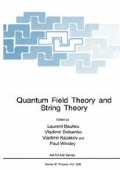Abstract
This contribution contains a summary of [1], which generalizes the linear systems that were derived already some time ago for the dimensionally reduced field equations of Einstein Yang-Mills theories [2, 3] and their locally supersymmetric extensions [4, 5]. These reductions correspond to solutions of the field equations, which depend on two coordinates only and thus possess at least two commuting Killing vectors. The construction of [1] differs from earlier treatments, which were all based on the (super) conformai gauge, in that it allows for non-trivial topologies of the two dimensional world sheets by taking into account the topological degrees of freedom of the world sheet, i.e. its moduli and supermoduli. These constitute extra physical (but non-propagating) degrees of freedom not present in the corresponding flat space integrable sigma models, and affect the dynamics in a non-trivial fashion. In particular, there is a “back reaction” of the matter fields on the topological degrees of freedom, in contrast to conformai field theories, where the moduli determining the background can be freely chosen. The spectral parameter t entering the linear system is now not only a function of the “dilaton” field as in [3, 4], but also depends on the moduli and super-moduli of the world sheet. It is subject to a pair of differential equations, whose integrability condition yields one of the equations of motion obtained by dimensional reduction of Einstein’s equations. Apart from these intriguing new structures, an important motivation for investigating the 2d supergravity models is the search for new symmetries generalizing the Geroch group [6] and the “hidden symmetries” of dimensionally reduced supergravities [7, 8, 9]. The results obtained in [1] indicate that, if such extensions of the Geroch group exist, they are likely to involve the topological degrees of freedom. It should be stressed, however, that even for the known classes of solutions, the global structure of the Geroch group is not fully understood (see [3] for a discussion).
Access this chapter
Tax calculation will be finalised at checkout
Purchases are for personal use only
Preview
Unable to display preview. Download preview PDF.
References
H. Nicolai, New Linear systems for 2D Poincaré Supergravities, preprint DESY 93-122 (1993), hep-th 9309052.
D. Maison, Phys. Rev. Lett. 41 (1978) 521; V.A. Belinskii and V.E. Zakharov, Zh. Eksp. Teor. Fiz. 75 (1978) 1955; 77 (1979) 3.
P. Breitenlohner and D. Maison, Ann. Inst. Poincaré 46 (1987) 215.
H. Nicolai, Phys. Lett. 194B (1987) 402; H. Nicolai and N.P. Warner, Commun. Math. Phys. 125 (1989) 384.
H. Nicolai, in Recent Aspects of Quantum Fields, Proceedings, Schladming 1991, eds. H. Mitter and H. Gausterer, Springer Verlag, 1991.
R. Geroch, J. Math. Phys. 12 (1971) 918, 13 (1972) 394.
E. Cremmer, S. Ferrara and J. Scherk, Phys.Lett. B74 (1978) 61; E. Cremmer and B. Julia, Nucl.Phys. B159 (1979) 141.
B. Julia, in Superspace and Supergravity, eds. S.W. Hawking and M. Rocek, Cambridge University Press, 1980.
B. Julia, in Unified Theories and Beyond, Proc. 5th Johns Hopkins Workshop on Current Problems in Particle Theory, Johns Hopkins University, Baltimore, 1982; in Vertex Operators in Mathematics and Physics, eds. J. Lepowsky, S. Mandelstam and I. Singer, Springer Verlag, Heidelberg, 1984.
B. de Wit, H. Nicolai and A. Tollsten, Nucl. Phys. B392 (1993) 3.
K. Khan and R. Penrose, Nature 229 (1970) 286; V. Ferrari and J. Ibanez, Gen. Rel. Grav. 19 (1987) 405.
B. de Wit, M. Grisaru, E. Rabinovici and H. Nicolai, Phys. Lett. B286 (1992) 78.
L. Baulieu and M. Bellon, Phys. Lett. 196B (1987) 142.
R. Dick, Chirat Fields on Riemann Surfaces and String Vertices, Thesis (Hamburg University, 1990); Lett. Math. Phys. 18 (1989) 67; Fortschr. Physik 40 (1992) 519.
M. Knecht, S. Lazzarini and R. Stora, Phys. Lett. 262B (1991) 25; 273B (1991) 63.
E. Verlinde and H. Verlinde, Phys. Lett. 192B (1987) 95; J. Atick, G. Moore and A. Sen, Nucl. Phys. B307 (1988) 221, B308 (1988) 1.
N. Steenrod, The Topology of Fiber Bundles, Princeton University Press, Princeton NJ, 1951.
A. R. Cooper, L. Susskind and L. Thorlacius, Nucl. Phys. B363 (1993) 132.
N. Marcus and J. Schwarz, Nucl. Phys. B228 (1983) 145.
J.L. Gervais and B. Sakita, Nucl. Phys. B34 (1971) 632.
D. Friedan and S. Shenker, Nucl. Phys. B281 (1987) 509.
T. Kornhass, Klassische Erhaltungsgrössen auf verzweigten Stringtrajektorien der Nambu-Goto Theorie, Thesis (Freiburg University, 1991).
Author information
Authors and Affiliations
Editor information
Editors and Affiliations
Rights and permissions
Copyright information
© 1995 Springer Science+Business Media New York
About this chapter
Cite this chapter
Nicolai, H. (1995). Linear Systems for 2D Poincaré Supergravities. In: Baulieu, L., Dotsenko, V., Kazakov, V., Windey, P. (eds) Quantum Field Theory and String Theory. NATO ASI Series, vol 328. Springer, Boston, MA. https://doi.org/10.1007/978-1-4615-1819-8_17
Download citation
DOI: https://doi.org/10.1007/978-1-4615-1819-8_17
Publisher Name: Springer, Boston, MA
Print ISBN: 978-1-4613-5735-3
Online ISBN: 978-1-4615-1819-8
eBook Packages: Springer Book Archive

